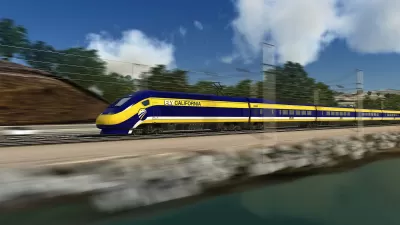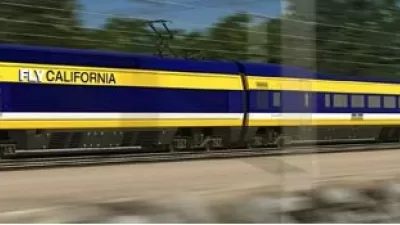Opposition, followed by legal action to the California High-Speed Rail project began in Northern California, spread to the Central Valley, and now has hit southern California, particularly in the San Fernando Valley of Los Angeles County.
In a series of articles, Ralph Vartabedian and Soumya Karlamangla of the Los Angeles Times examine the growing opposition to the project, including 300 people attending a June 9 High-Speed Rail Authority meeting in downtown Los Angeles. "Rail board chairman Dan Richard said the meeting was the biggest protest he could recall during his tenure."
As the detailed planning process begins to shift to Southern California, community leaders and neighborhood groups are launching challenges to a segment that would run between Palmdale and Burbank.
The meeting "followed the release of a key report that analyzed the effects of four different routes," they write. "The 62-page analysis shows that within half a mile of the track from Palmdale to Burbank, there could be noise and vibration affecting about 20,000 residences, 25 parks, 47 schools, 48 churches and nine hotels, as well as archaeological sites and wetlands."
Unlike opposition from three affluent, predominantly white communities on the San Francisco Peninsula, "several low-income and predominantly minority communities, including San Fernando, Pacoima and Sylmar, complained that their neighborhoods would be divided by 20-foot-high sound walls along the high-speed train corridor. Some said their areas had been already been chopped up by three major freeways and a dozen dumps."
In a related article, Vartabedian and Karlamangla write that "a coalition of communities is demanding that only routes that are predominantly underground should be considered."
The growing resistance is coming in part from urban, working-class neighborhoods that are portraying the surface route as an environmental injustice. Notably, those communities are longtime supporters of state Democrats who championed the project."
Vartabedian and Karlamangla detail the four routes. "It wasn't immediately clear how the outpouring of opposition might affect decisions about a route, which could take two years of environmental research and planning to complete."
FULL STORY: Bullet train runs into rising opposition over Southern California routes

Planetizen Federal Action Tracker
A weekly monitor of how Trump’s orders and actions are impacting planners and planning in America.

Congressman Proposes Bill to Rename DC Metro “Trump Train”
The Make Autorail Great Again Act would withhold federal funding to the system until the Washington Metropolitan Area Transit Authority (WMATA), rebrands as the Washington Metropolitan Authority for Greater Access (WMAGA).

DARTSpace Platform Streamlines Dallas TOD Application Process
The Dallas transit agency hopes a shorter permitting timeline will boost transit-oriented development around rail stations.

LA County Creating Action Plan to Tackle Extreme Heat
Los Angeles County is creating a Heat Action Plan to help communities stay safe during extreme heat, with steps like adding more shade, improving buildings, and supporting the neighborhoods most at risk.

Maryland Plans Quick-Build Complete Streets Projects
The state will use low-cost interventions to improve road safety in five Maryland counties.

Downtown Los Angeles Gears Up for Growth
A new report highlights Downtown L.A.’s ongoing revival through major housing projects, adaptive reuse, hospitality growth, and preparations for global events in the years ahead.
Urban Design for Planners 1: Software Tools
This six-course series explores essential urban design concepts using open source software and equips planners with the tools they need to participate fully in the urban design process.
Planning for Universal Design
Learn the tools for implementing Universal Design in planning regulations.
City of Charlotte
Municipality of Princeton
Roanoke Valley-Alleghany Regional Commission
City of Camden Redevelopment Agency
City of Astoria
Transportation Research & Education Center (TREC) at Portland State University
US High Speed Rail Association
City of Camden Redevelopment Agency
Municipality of Princeton (NJ)




























